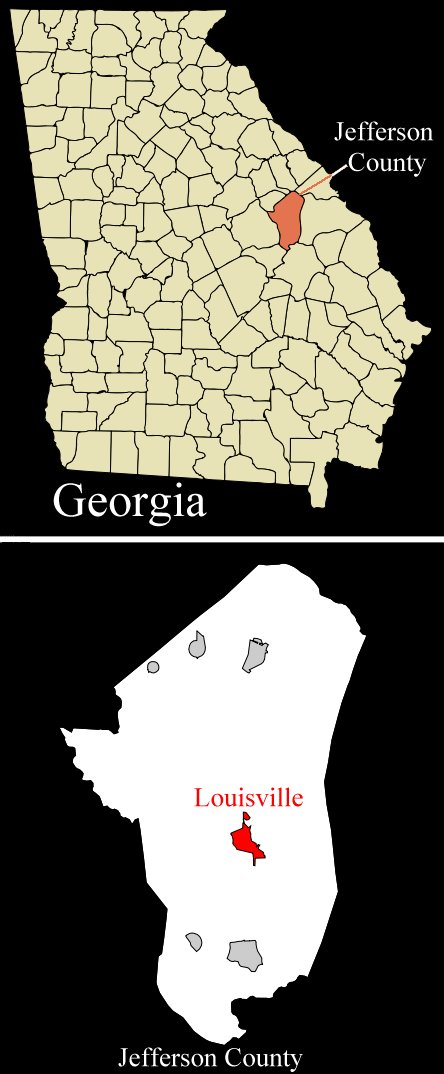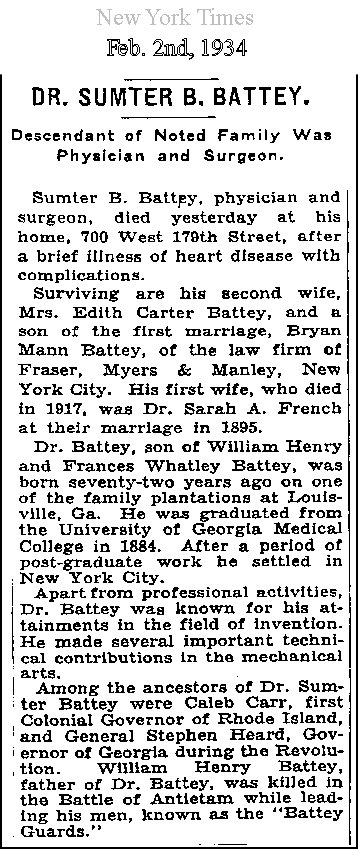Do you have a photo of this soldier? Do you have a bio of your ancestor who served in the 38th Ga.? If you send it, I'll post it here. Please email me at dnichols16@cox.net.
---------------------------------------------------------
Captain William Henry Battey was born was in the Louisville, Jefferson County, Georgia, on Sept 19th, 1820. In 1860, he was a wealthy planter, owning a large plantation with land holdings valued at over $15,000, which was a considerable sum in 1860. He also owned 80 slaves (37 females and 43 males) to cultivate his fields and tend to his plantation, the slaves being valued at nearly $58,000. By 1860, he had constructed a tannery on his plantation and placed an advertisement in the local newspaper stating that he was seeking to purchase animal hides for tanning.

When war became imminent, William Battey organized a company from Jefferson County that took the name "Battey Guards." This company became Company G of the 38th Georgia and was accepted into the Confederate service on October 1st, 1861. Capt. Battey served with distinction during the Battle of Gaines Mill, Virginia, fought on June 27th, 1862. Capt Battey assumed command of the regiment after all the senior officers were wounded. He would retain command of the regiment until he was killed in battle on September 17th, 1862.
When the sun rose over the foggy fields near Sharpsburg, Maryland on September 17th, 1862, Lawton’s Brigade was arrayed just south of D. R. Miller's forty acre corn field, their line stretching from east to west. The 38th Georgia, numbering only about 123 men, was commanded by Captain William Battey.
Capt. William C. Mathews recalled that after the battle of Cedar Mountain, fought Aug 9th, 1862, “Major Battey, who had led the regiment since the battle of Cold Harbor (Gaines Mill), was taken violently ill and turned over command to Capt. R. P. Eberhardt, the senior Captain present.”
At Antietam, Capt. W. C. Mathews continued, “We had the misfortune to lose our brave Major, W. H. Battey, one of the best men in the service. He had left his sick bed to overtake us. Was not hardly able to sit on his horse, but his will and courage carried him onto the battlefield."
The battle began just before sunrise and Federal artillery, located across Antietam Creek to the east, opened fire on Lawton’s Brigade. The artillery fire may have been the signal for the northern infantry to advance, for almost immediately Lawton's Brigade's skirmishers fell back on the main line as the Federal infantry advanced in a considerable force. Some of the skirmishers hastily crossed a wooden fence at the southern edge of the cornfield and were guyed by other brigade members with, "What are you running for?" "You'll soon see!" was the reply from the skirmishers. The regimental flags of the Federal infantry revealed immense numbers of Yankees advancing through the corn to the front and woods to the right front, on a collision course with Lawton’s Brigade, which numbered only about 1,200 men.
Captain Battey didn’t live to see the next two hours of fierce combat endured by the 38th Georgia Regiment and Lawton’s Brigade. In fact, soon after sunrise he was struck down and "cut in two" by a solid shot cannon ball passing through his body, during the fierce Federal artillery barrage. Of the 123 men of the 38th Georgia who took to the field that morning, 94 were killed or wounded within two hours, including the gallant commander, Captain William Battery, who lay dead on the field of battle. Captain Battey was described by one member of the 38th Georgia as a "brave and noble man." When roll was called that evening, only 28 men and three officers were present to gather around the colors of the 38th Georgia. The three officers left were Lieutenants Wells, Baxter and Matthews.
The Confederate dead of Lawton’s Brigade reportedly received a decent burial, once the Confederate Army retreated across the Potomac River the following evening. “Decent burial,” probably meant they were buried by Federal soldiers in mass graves just south of the cornfield where they fell. The Federal dead of Antietam were removed once the war ended and are buried in the well maintained National Cemetery at Sharpsburg, but the Confederate dead were left to molder in their shallow graves scattered across the battlefield. In 1869 a survey was conducted of the Confederate graves at Antietam by the State of Maryland. Many of the graves were so shallow that bones and other accoutrements could be seen protruding from the Southern hero’s graves.
Once annotation in the survey conducted by the State of Maryland noted, “Eight trenches supposed to contain 305 unknown CSA soldiers in D.R. Miller’s field, west of pike and joining the woods; bones exposed.”
These eight trenches undoutedly contained the remains of many members of Lawton’s Brigade and the 38th Georgia. In 1877, over a decade after the war had ended, those Confederate soldiers who were known to be killed in the battle Antietam were finally exhumed and reburied in Washington Confederate Cemetery, located inside Rose Hill Cemetery, Hagerstown, Maryland. Of these 2,468 CSA soldiers buried at Rose Hill, only 346 are known and only one member from the 38th Georgia is identified, Private Mathew Coleman of the Ben Hill Guards, Company C. The Confederate cemetery dedication took place on June 15th, 1877.
One of the unknown Confederate Soldiers buried at Rose Hill Cemetery may be the gallant Captain William Henry Battey of Jefferson County, Georgia. There is a cenotaph in the Battey - Heard Cemetery in Jefferson County, dedicated to his memory. The momument reads "Sacred to the memory of Capt. Wm. Henry Battey, His three children are buried beneath this monument." One of the children buried beneath the monument is Capt. Battey's little boy, Henry Lindsey Battey who was six years old when he died in 1851.
He left behind a wife, Mrs. Frances Whatley Battey and four children. In 1862 Mrs. Frances R. Battey was 40 years old, her children were: William W., age 14, Ruth E., age 8, Francis C, age 5, Sumter B, age 1.
Below is the obituary of his son Sumter B. Battey, who became a medical doctor and died in 1934.

Photo of tombstone courtesy of Diana Gunn.